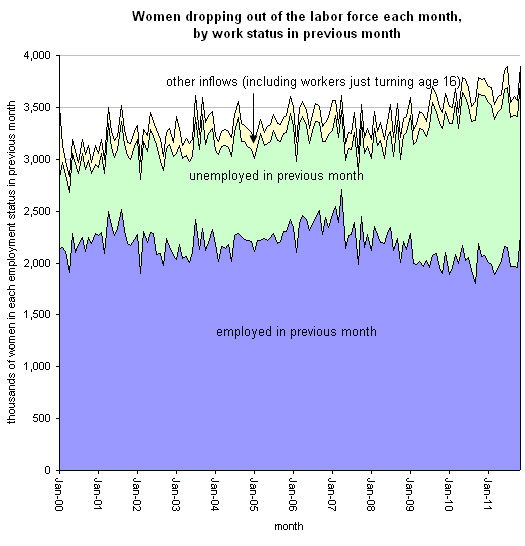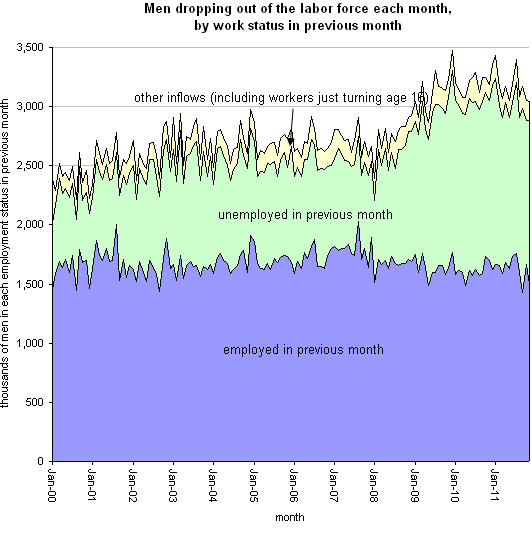On Tuesday I wrote about how the entirety of the net decline in the labor force last month could be explained by women dropping out. I also puzzled over why a majority of women who left the labor force happened to have been employed before they opted out, because the stereotypical labor force dropout is usually an unemployed worker who got discouraged and gave up looking for a new job.
Since then I’ve dug into the history of labor force dropouts and what workers usually do right before they leave the labor force. As it turns out, November’s breakdown was not terribly unusual; a majority of women who leave the labor force each month are usually coming directly from a job (perhaps because they’re retiring, going on maternity leave or are laid off and not seeking re-employment):
 Source: Bureau of Labor Statistics, job flows data Note: Numbers in chart refer to gross number of job-leavers, and so do not subtract out the number of workers joining the labor force. Data are seasonally adjusted.
Source: Bureau of Labor Statistics, job flows data Note: Numbers in chart refer to gross number of job-leavers, and so do not subtract out the number of workers joining the labor force. Data are seasonally adjusted.
Note, however, that the number of women who leave the labor force directly from a job has actually fallen in the last few years, while the number of women leaving the labor force after having been recently unemployed has risen. This supports the discouraged-worker explanation of recent trends.
The same is true for men. As with female dropouts, typically most of the men who leave the labor force each month have been leaving directly after holding a job:
 Source: Bureau of Labor Statistics, job flows data Numbers in chart refer to gross number of job-leavers, and so do not subtract out the number of workers joining the labor force. Data are seasonally adjusted.
Source: Bureau of Labor Statistics, job flows data Numbers in chart refer to gross number of job-leavers, and so do not subtract out the number of workers joining the labor force. Data are seasonally adjusted.
But while the number of men dropping out directly after holding a job (e.g., retirees) has stayed relatively flat in recent years, the number of men dropping out of the labor force after a spell of unemployment has risen.
Part of last month’s bizarre dropout pattern has been solved, then: In any given month of the last decade most of the people dropping out of the labor force have been leaving jobs, but the reason the total number of dropouts has risen more recently is that more unemployed workers have given up applying for jobs. Again, it’s the discouraged-worker narrative.
That still leaves some gender dynamics to be explained, though.
During the recession, which technically lasted from December 2007 to June 2009, some men dropped out of the labor force, and many times more women joined it. Many of these new female workers were probably stepping up as breadwinners when their husbands were laid off.
During the recovery, which extends from June 2009 to the present, both men and women have dropped out of the labor force, but many more women have dropped out than men.
Probably female dropouts have exceeded male dropouts lately because state and local government layoffs have disproportionately hit women. And as those women are laid off, they may become too discouraged by the sorry job market to even apply for new positions.
Article source: http://feeds.nytimes.com/click.phdo?i=605957ca717beaee5ad7c8bb720a58cd